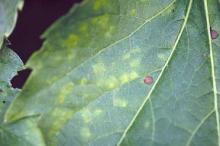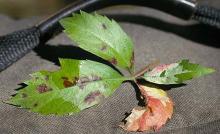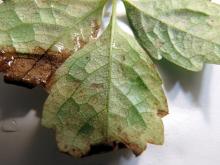See:
Grape (Vitis spp.) - Downy Mildew
Cause The fungus-like organism Plasmopara muralis (formerly Plasmopara viticola clade quinquefolia) was detected on Boston ivy plants in the landscape and grown as nursery plants in Oregon in late 2001. Surveys during 2002 found the disease at many wholesale and retail nurseries in both Oregon and Washington. Both Boston ivy and Virginia creeper were found infected. One landscape planting of Boston ivy without overhead irrigation had symptoms and signs of the disease. This may indicate that western Oregon can sustain natural spread and expression of this disease.
Laboratory and field tests have shown that the strain on Boston Ivy was unable to infect grape.
It can be spread by transporting infected vines, nursery stock or within plant debris or soil that contains oospores of the organism. The organism can overwinter or be transmitted as mycelium in dormant buds. Overhead irrigation during the summer encourages disease development.
Symptoms Greenish-yellow, angular blotches appear on the upper leaf surface. The lower leaf surface has light-brown spots covered with a white, fungal growth during moist weather. Late in the season lesions turn dark-brown-to-black before leaves fall from the vine. Lesions can be on any green part of the vine. Heavily infected leaves may fall prematurely.
Cultural control Scout for symptoms of the disease.
- Do not transport infected stock into the region.
- Scout plants for any sign of the disease. Check newly planted stock originating out of state. If it is suspected, get diseased plant samples to a public diagnostic laboratory as soon as possible to confirm the diagnosis.
- Remove and destroy infected plant and plant parts.
- Space plants for better air circulation. Water in the morning or in such a way that leaves do not remain wet for extended periods of time. Use drip irrigation.
- Maintain adequate fertility.
Chemical control There are no fungicides specifically registered for this crop. These fungicides are legal to use if not phytotoxic and may have activity against this disease:
- Aliette at 2.5 lb/100 gal water. Do not use within 14 days of copper spray. Do not use with adjuvants. Group P7 fungicide. 24-hr reentry.
- Fosphite at 1 to 2 quarts/100 gal water. Do not use copper products within 20 days of treatment and do not use spray adjuvants. Group P7 fungicide. 4-hr reentry.
- Heritage at 2 to 4 oz/100 gal water plus a non-silicone-based wetter sticker. Group 11 fungicide. 4-hr reentry.
- Segovis at 0.6 to 3.2 fl oz/100 gal water plus another fungicide. Group 49 fungicide. 4-hr reentry.
- Stature SC at 6.12 to 12.25 fl oz/100 gal water. Group 40 fungicide. 12-hr reentry.
References Rouxel, M., Mestre, P., Baudoin, A., Carisse, O., Delière, L., Ellis, M.A., Gadoury, D., Lu, J., Nita, M., Richard-Cervera, S. and Schilder, A. 2014. Geographic distribution of cryptic species of Plasmopara viticola causing downy mildew on wild and cultivated grape in Eastern North America. Phytopathology 104:692-701.
Thines, M. 2011. Recent outbreaks of downy mildew on grape ivy (Pathenocissus tricuspidata, Vitaceae) in Germany are caused by a new species of Plasmopara. Mycol Progress 10:415-422.






